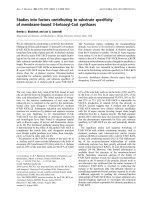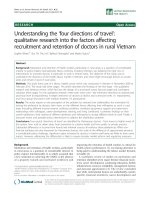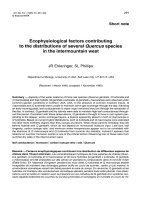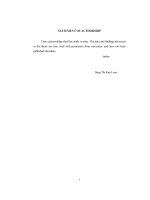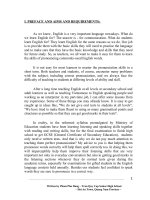Understanding the factors contributing to students lack of concentration at school
Bạn đang xem bản rút gọn của tài liệu. Xem và tải ngay bản đầy đủ của tài liệu tại đây (81.81 KB, 4 trang )
1. Understanding the Factors Contributing to Students' Lack of Concentration at School
Students' lack of concentration at school has become a prevalent issue in recent years. By
understanding these reasons, educators, parents, and policymakers can work collaboratively to
address this issue and create an environment that promotes better focus and engagement in the
learning process.
One significant factor contributing to students' lack of concentration is the pervasive influence
of digital distractions. With the advent of smartphones, tablets, and laptops, students are consistently
exposed to a multitude of distractions, such as social media platforms, online games, and instant
messaging applications. The constant connectivity offered by these devices creates a considerable
challenge for students to resist the temptation of engaging in non-academic activities, diverting their
attention away from classroom learning. Fatigue and sleep deprivation also play a substantial role in
students' inability to concentrate effectively. Many students face demanding schedules, juggling
academics, extracurricular activities, and social commitments. The pressure to meet academic
expectations often leads to long study hours and a lack of sufficient sleep. As a result, students may
struggle to maintain focus and attention during classes, leading to decreased concentration levels and
diminished academic performance.
The teaching and learning approaches employed in schools can significantly impact students'
concentration levels. Traditional lecture-style teaching, which primarily focuses on delivering
information without actively engaging students, can be monotonous and fail to capture students'
attention. Lacking interactive and participatory elements, these methods may not cater to diverse
learning styles, leading to boredom and disinterest among students. In contrast, incorporating
interactive activities, discussions, and hands-on experiences can enhance students' concentration
levels by actively involving them in the learning process. The physical classroom environment itself
can also hinder students' concentration. Factors such as noise, inadequate seating arrangements, and
poor classroom management can disrupt students' ability to focus. External distractions, including
classmates' behavior, external sounds, or visual clutter, can draw students' attention away from the
lesson.. Personal factors and mental health issues can greatly impact students' concentration at
school. External stressors, such as family problems, peer pressure, or personal insecurities, can
consume students' thoughts and distract them from their studies. Moreover, underlying mental health
conditions such as anxiety, depression, or attention disorders can impair students' ability to
concentrate effectively.
In order to address the issue of students' lack of concentration at school, it is essential to
implement effective solutions to create an environment that fosters better concentration, leading to
improved academic performance and overall well-being. Considering the influence of digital
distractions, it is crucial to promote a "digital detox" approach to enhance students' concentration.
Educators can implement policies that limit the use of smartphones and other electronic devices during
class hours. Alongside this, teaching students about responsible device usage, including time
management and setting boundaries, can help them develop healthy digital habits. By reducing the
constant availability of distractions, students can more effectively concentrate on their studies. To
address the impact of fatigue and stress on concentration, it is important to promote mindfulness and
stress management techniques. Incorporating mindfulness exercises, such as deep breathing or
meditation, into the daily routine can help students relax, reduce stress levels, and improve their ability
to concentrate. Additionally, teaching stress management techniques such as time management,
prioritization, and effective study strategies can empower students to handle their workload more
efficiently, reducing stress-related distractions.
Creating engaging and interactive learning environments is crucial for enhancing students'
concentration. Educators can employ innovative teaching strategies that involve students actively in
the learning process, such as project-based learning, hands-on experiments, and group discussions.
By encouraging participation and collaboration, these approaches stimulate students' interest and
enhance concentration. Furthermore, incorporating technology in the classroom, when used
purposefully, can provide interactive learning experiences that captivate students' attention and
enhance their focus. An optimized classroom environment can significantly impact students'
concentration levels. Teachers can ensure a conducive learning environment by minimizing
distractions, providing comfortable seating arrangements, and maintaining appropriate lighting and
acoustics. Additionally, effective classroom management strategies, such as clear expectations,
consistent routines, and proactive behavior management, can create a positive atmosphere that
supports concentration. Teachers can also implement visual cues, such as classroom rules or focus
indicators, to help students stay on task. Promoting student engagement and personal development is
essential for enhancing concentration at school. By incorporating student-centered activities and
projects, educators can foster intrinsic motivation and enhance students' sense of ownership and
responsibility towards their learning. Encouraging extracurricular activities, clubs, or hobbies that align
with students' interests and passions can provide a well-rounded educational experience, promoting
personal growth and cultivating focus and concentration along the way.
1. What are the three main reasons for students' lack of concentration at school?
2. How can digital distractions impair students' concentration?
3. What are the consequences of fatigue and sleep deprivation on students' ability to
concentrate?
4. How can traditional lecture-style teaching methods contribute to students' boredom and
disinterest?
5. What are some factors in the physical classroom environment that can hinder students'
concentration?
6. How can personal factors and mental health issues impact students' concentration at school?
7. What are some effective strategies to promote a "digital detox" approach to enhance students'
concentration?
8. How can mindfulness and stress management techniques help students improve their ability to
concentrate?
9. What are some innovative teaching strategies that can enhance students' concentration and
engagement in the learning process?
10. How can an optimized classroom environment and effective classroom management strategies
support students' concentration?
2. The Dichotomy of Mathematics in Business Success: A Debate
The question of whether one needs to be good at math in order to succeed in a business is a
topic of debate. By understanding the relationship between math and business, individuals can make
informed decisions regarding the importance of mathematical skills in their entrepreneurial pursuits.
Mathematics plays a vital role in analytical decision-making, which is a key component of
successful business operations. Financial analysis, market research, and cost estimation all require
the ability to interpret numerical data accurately. By utilizing mathematical concepts such as statistics,
probability, and data analysis, business professionals can make informed decisions based on
quantitative evidence. From identifying opportunities for growth to optimizing resource allocation, the
ability to analyze data using mathematical skills is essential for achieving business success. Sound
financial management is crucial for the success of any business. This requires careful budgeting,
forecasting, and financial planning, all of which heavily rely on mathematical skills. Understanding
concepts like compound interest, cash flow analysis, and risk management enables business owners
to effectively track revenue, control expenses, and make strategic financial decisions. Furthermore,
being proficient in math empowers individuals to evaluate investment opportunities, assess profitability,
and effectively manage financial risks, contributing to long-term business success.
Efficient operations and inventory management are vital for maintaining smooth business
operations. Mathematics aids in optimizing production processes, determining optimal inventory levels,
and minimizing waste. Analytical tools such as linear programming and optimization techniques enable
businesses to streamline their operations, maximize productivity, and reduce costs. By using
mathematical models, managers can make informed decisions regarding production scheduling,
resource allocation, and supply chain management, improving overall efficiency and profitability.
Market analysis and sales forecasting are integral in developing effective marketing strategies and
driving business growth. By utilizing mathematical techniques such as trend analysis, regression
models, and predictive analytics, businesses can identify market trends, forecast demand, and
anticipate customer preferences. These mathematical tools empower businesses to strategically
position their products or services, identify target markets, and allocate resources accordingly. By
leveraging math in market analysis, businesses can gain a competitive edge, maximize sales, and
establish a strong market presence.
While mathematical skills are undeniably useful in certain aspects of business, relying solely on
them for success overlooks other vital factors. Overemphasis on math can lead to an underestimation
of the value of interpersonal skills, intuition, creative problem-solving, and adaptability. First,
adaptability and problem-solving skills are equally crucial for success. Businesses must navigate
ever-changing market conditions and overcome various challenges. The ability to think critically and
develop innovative solutions is essential. The business landscape is constantly evolving, driven by
technological advancements, changing consumer behavior, and global economic shifts. In such a
dynamic environment, adaptability is crucial. While mathematical skills equip individuals with the ability
to analyze data and make predictions, they do not guarantee adaptability. A successful entrepreneur
must possess the agility to learn new skills, adapt to emerging trends, and embrace innovation.
Effective communication and networking skills are also paramount to building strong relationships and
securing opportunities. The ability to articulate ideas, negotiate deals, and build partnerships can open
doors and create connections that exceed the limits of mathematical knowledge alone. By focusing on
interpersonal skills, entrepreneurs can cultivate their professional networks, attract investors, and
establish a solid customer base. A key ingredient for success in business lies in emotional intelligence
and effective leadership. While math skills may contribute to analytical decision-making, the ability to
understand and manage emotions, empathize with others, and inspire a team can significantly impact
business outcomes. Leaders who excel in these areas can foster a positive work environment,
increase productivity, and effectively address challenges by leveraging the strengths of their team
members.
Creativity and innovation are crucial elements in today's rapidly evolving business landscape. While
math skills can aid in quantitative analysis, generating new ideas, identifying opportunities, and
reimagining business models require a different skill set. Entrepreneurs who possess creative thinking
skills can develop unique products, services, or marketing strategies that set them apart from the
competition. By embracing innovation, businesses can adapt to changing consumer demands and stay
relevant in the marketplace. Collaboration and teamwork are often essential for tackling complex
business problems and driving collective success. While mathematical proficiency may assist in
problem-solving, the ability to collaborate effectively and bring together diverse strengths is invaluable.
Entrepreneurs who prioritize building a cohesive and motivated team can achieve more by combining
various skill sets and perspectives, fostering a culture of creativity and collaboration. Combining the
strengths of individuals from different backgrounds - be it finance, marketing, technology, or design -
creates a well-rounded team capable of solving complex challenges. Business success is often a
collective effort that necessitates leveraging diverse skills rather than relying solely on mathematical
proficiency.
In conclusion, the importance of mathematics in business success is a topic of debate. While
mathematics undoubtedly provides valuable tools for data analysis, financial management, and
decision-making, it is not the sole determinant of success. Intangible skills, such as effective
communication, creativity, and adaptability, play equally vital roles in achieving business success.
3. The Global Glimpse: Debating the Superiority of Video Records over Written Documents in
Understanding Diverse Lifestyles
The question of whether video records or written documents provide a better understanding of
how people live across the world is a subject of debate. By evaluating the immersive experience of
videos and the in-depth analysis of written documents, we can better comprehend their roles in
fostering cross-cultural understanding.
Video records offer a unique and immersive experience that captures the essence of people's
lives across the globe. They provide a multi-dimensional view, showcasing everyday routines, cultural
practices, and social interactions. Through videos, viewers can observe and interpret body language,
facial expressions, and environmental contexts that are vital to understanding the cultural nuances of
different communities. Visual narratives in videos have the potential to evoke empathy and foster a
deeper connection with the subject matter, making them an effective tool for learning about diverse
lifestyles. Despite their immersive nature, video records may present a limited perspective on the way
people live in different parts of the world. Videos can be subjective, influenced by the filmmakers'
biases, editing choices, and the intended portrayals of the subjects. Additionally, the time constraints of
videos may limit the scope of information and context provided, potentially leading to oversimplification
or misinterpretation. The power of visual storytelling in videos should be balanced with a critical
awareness of their limitations in capturing the entirety of diverse lifestyles.
While videos provide a powerful visual experience, written documents offer the advantage of
depth and analysis. With written texts, readers can access a wealth of historical and sociocultural
context, allowing for a more comprehensive understanding of different cultures and ways of life. The
written word often undergoes critical analysis and fact-checking, ensuring a higher degree of accuracy
and careful representation of information. Written documents also allow for contemplation and
reflection as readers engage with the material at their own pace, enabling a deeper understanding of
complex subjects. Written documents offer an analytical approach to understanding diverse lifestyles,
providing a platform for different viewpoints and expert analysis. Literary works, research papers, and
ethnographic studies offer intricate and in-depth insights into cultural practices, beliefs, and societal
structures. The written word provides the opportunity for documentation, interpretation, and historical
preservation, thus fostering a deeper comprehension of the diversity of human experiences. Written
documents also facilitate cross-referencing and cross-cultural comparisons, allowing for a more
nuanced understanding of the differences and similarities among various cultures.
Rather than pitting video records against written documents, it is important to recognize that they can
be complementary tools for cross-cultural understanding. Combining immersive visuals with detailed
analysis can offer a more comprehensive and well-rounded perspective. Videos can provide a
captivating introduction to different ways of life, while written documents can offer the critical context
and depth of information needed to form a holistic understanding. By utilizing both mediums,
individuals can cultivate a richer understanding of diverse lifestyles around the world.
In conclusion, the superiority of video records or written documents in learning about the way people in
the world live is a contentious subject. Videos offer immersive visual narratives that evoke empathy,
while written documents provide analytical depth and context. Recognizing the unique strengths of
each medium and their respective limitations, it becomes evident that both video records and written
documents play important roles in fostering cross-cultural understanding. Combining these tools can
lead to a more comprehensive comprehension of diverse lifestyles, allowing individuals to develop a
deeper appreciation for the complexities and interconnectedness of our global society.
